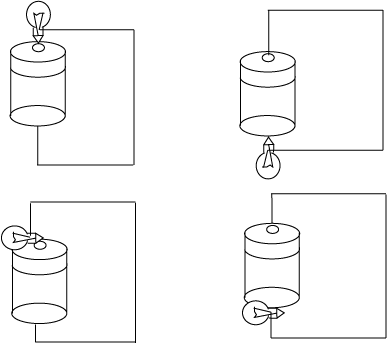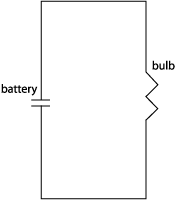|
Direct Current
|
|
|
| Solutions |
| Q1: Draw four different arrangements to light the bulb as both drawings and schematics. |
 |
| The schematic is the same for all: |

|
| Q2: What
are the common characteristics of all of your bulb lighting arrangements
(also called "circuits")? All of the circuits have a circular path for electrons to travel from the battery through the lamp and then back to the battery. Q3: In your own words describe the path of a single electron if it is given enough time to move through your circuit. A single electron, given enough time, would start near the negative end of the battery. From there it would meander along the wire at a relatively leisurely pace until it got to the light bulb. There, it would collide with the atoms in the filament, giving up some of its energy (potential) to the atoms, which then radiate that energy as light. After leaving the bulb, the electron would again slowly move towards the positive end of the battery, following a haphazard path along the wire until it reached the battery, and the last of its potential was exhausted. Q4: In your own words describe the electrical potential of a single electron as it moves completely around your circuit. How much potential must the electron lose as it returns to its original location? At the beginning the circuit, the electron has the most potential. This is equal to the voltage of the battery. Its potential stays nearly the same as it traverses the wire to the bulb, but there most of its potential is used to light the bulb. Once the electron reaches the other end of the battery, it has no potential left. Q5: Using a diagram and your own words, describe how an incandescent light bulb works. The electrons enter the light bulb filament with relatively high kinetic energies. As they travel through the filament they collide with metal atoms transferring mush of their kinetic energy to the metal. This energy raises the temperature of the metal. The metal in turn radiates this energy as electromagnetic waves, many in the visible spectrum. |
|
|
|
|